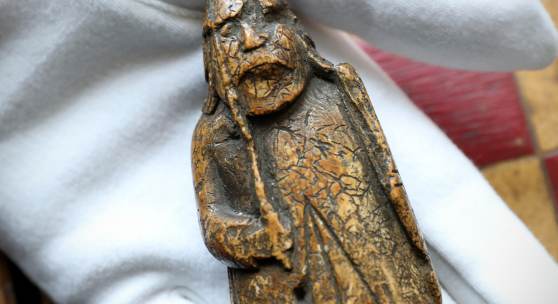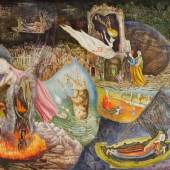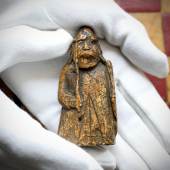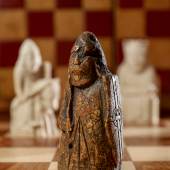A Newly-Discovered Lewis Chessman Appears at Auction
-
Auktion02.07.2019
The late months of 1831 saw a period of political turmoil with popular riots across southern England and south Wales, not a good time to solicit funds to buy a hoard of ivory chessmen from Scotland. However, despite certain parliamentary opposition, and harnessed in his endeavours by a few of the British Museum’s Trustees, Madden was successful in bringing 81 of the Lewis Chessmen to the museum, for a sum of 80 guineas, a great deal of money at the time, and knocked down by Madden from 100 guineas. Aside from his original purchase, Sharpe was later able to buy another piece from an owner on Lewis, and it is these 11 pieces that make up the collection held by the National Museum of Scotland.
THE ORIGINS OF THE LEWIS CHESSMEN
Scholars have proposed competing theories on the origins of the Lewis Chessmen, their style and iconography not restricted to one centre. The leading theory is that they are Norwegian, and more precisely probably from Trondheim, which seems to have specialised during the 12th and 13th centuries in carving gaming pieces, often from walrus ivory. Trondheim was the seat of the archbishop of Norway, with the island of Lewis under its authority as part of the kingdom of Norway from early Viking times up to the Treaty of Perth in 1266. The theory that the Lewis hoard was the stock of a trader in chess pieces buried after a shipwreck was first proposed by Frederic Madden and has been the favoured explanation of their discovery ever since. The good condition of the individual pieces and their apparent lack of wear supports the theory that they were the stock of a trader in chessmen that never reached their market.
THE IMPORTANCE OF THE LEWIS CHESSMEN
Recognised as an important symbol of European civilisation, the Lewis Chessmen were included by Neil Macgregor, former director of the British Museum, in his BBC Radio 4 series, A History of the World in 100 Objects. He commented that ‘if we want to visualise European society around the year 1200, we could hardly do better than look at how they play chess. And no chess pieces offer richer insights than the… Lewis Chessmen’.
This notion was equally understood at the time the Lewis Chessmen were made, as evidenced in a 13th-century Communiloquium written by the Franciscan, John of Wales: ‘The whole world is like a chessboard, of which one square is white and another black, following the dual state of life and death, praise and blame. The society (familia) of this chessboard are men of this world, who are all taken from a common bag, and placed in different part of this world, and as individuals have different names. One is called king, another queen, a third rook, a fourth knight, a fifth alphin [bishop], a sixth pawn’. The Lewis Chessmen are remarkable in that the survival of each one of the familia allows us insights into the characters of each individual with incomparable vividness, imagining their strengths and vulnerabilities. Through dress and gesture, it becomes possible to read the social hierarchy within the group.
THE NEW LEWIS WARDER AND HIS FELLOW CHESSMEN
The warders that made up the hoard are of two types: the majority are bearded with a sword in their right hand and shields either at their left side or in front, and three are shown biting the tops of their shields, identifying them as the legendary Norse warriors known as berserkers. The new Lewis Warder is completely consistent not only with his fellow warders but also with the surviving group as a whole.
-
16.01.2020 - 19.01.2020Die Specials und Sonderschau der 24. ART Innsbruck, die Mittwochabend in der Innsbrucker...
-
Ankauf und Verkauf von Kunstwerken und Antiquitäten
-
20.04.2024 - 24.11.2024Jeffrey Gibson on Representing the United States and Himself By Melissa Smith | Feb 16, 2024 From...
-
13.05.2024 - 15.05.2024Sotheby’s Sealed is thrilled to present this spectacular Mercedes-Benz 300 SL Alloy...
-
14.05.2024Warhol & Basquiat’s Collaboration Series Masterwork To Highlight Sotheby’s...
-
15.05.2024T he most significant work by the celebrated Surrealist artist Leonora Carrington, Les...
-
02.07.2019Auktion »
.















